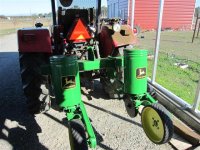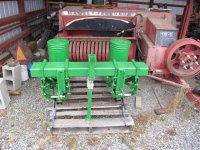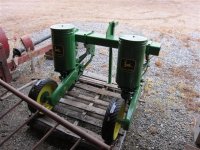To me, the most important thing to look for in a corn planter (new or used) is that it has "real" fertilizer attachments. This is a big money saver down the road, as it lets you get all the fertilizer (including nitrogen) that the corn needs for very good yields, as you plant it. This is especially true if using RR corn seed, where all the weed competition, in the rows, can be wiped out later, while cultivating. At planting, simultaneously, all the fertilizer is buried, right next to the rows, where it is most needed. There is no need to wait until "right before a rain", or waste most of the fertilizer between the rows as is the case if a broadcast spreader is used.
The reason I say "real" fertilizer spreaders, is you have to look out for folks pushing "insecticide applicators" as "fertilizer applicators", especially on the very popular JD model 71's. An insecticide applicator has neither the volume, rate capacity, or corrosion resistance to be used on fertilizer. You will know you have a "real" fertilizer applicator if the fertilizer hopper is larger than the seed hopper.
It is quite difficult to locate an old, used planter with functioning fertilizer applicators. That is because fertilizer is so corrosive and most have rusted out years ago. I was lucky to find an old 3-pt JD model 246, with good fertilizer applicators, many years ago. I have been very careful to clean it good after every use so that the fertilizer attachments remain good. If you are unable to locate a planter with fertilizer attachments, another option is to locate an old cultivator tractor (Like a Farmall Super-A or Cub) that has a good side-dresser. That is not quite as good of option as the planter because it does not give the corn seeds the "startup" boost that they really could use.




